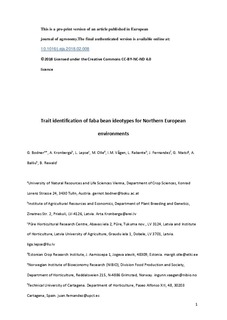| dc.contributor.author | Bodner, Gernot | |
| dc.contributor.author | Kronberga, Arta | |
| dc.contributor.author | Lepse, Liga | |
| dc.contributor.author | Olle, Margit | |
| dc.contributor.author | Vågen, Ingunn Molund | |
| dc.contributor.author | Rabante, Lasma | |
| dc.contributor.author | Fernández, Juan A. | |
| dc.contributor.author | Ntatsi, Georgia | |
| dc.contributor.author | Balliu, Astrit | |
| dc.contributor.author | Rewald, Boris | |
| dc.coverage.spatial | Europe | nb_NO |
| dc.date.accessioned | 2019-04-08T07:51:26Z | |
| dc.date.available | 2019-04-08T07:51:26Z | |
| dc.date.created | 2018-03-14T13:50:50Z | |
| dc.date.issued | 2018-03-07 | |
| dc.identifier.citation | European Journal of Agronomy. 2018, 96 (May 2018), 1-12. | nb_NO |
| dc.identifier.issn | 1161-0301 | |
| dc.identifier.uri | http://hdl.handle.net/11250/2593620 | |
| dc.description.abstract | European pulse production faces a continued loss of cultivated area along with decreasing or stagnant yields. Vicia faba is a traditional legume with high genetic diversity cultivated in a wide range of European climates. Therefore V. faba is promising to identify stable and high yielding genotypes for specific target environments. The Nordic-Baltic region is challenging for legume growing due to short vegetation period and heat/drought stress in continental climates. Within the pan-European Eurolegume project a set of 18 V. faba accessions containing var. minor and major local landraces and modern cultivars of different geographical origin was evaluated in multi-environmental trials. The aim of this study was to identify ideotypes for Northern Europe and reveal key phenotypic traits conferring high yield potential and stability. Four target environmental clusters represented the range of Nordic growing conditions with yield levels from 128 gm−2 to 380 gm−2. Multivariate classification differentiated distinctive groups of var. minor and var. major accessions with few overlapping genotypes, the former having higher average yield, taller structure, more pods per node and longer flowering duration. Late sowing under long-day conditions above 55°N latitudes resulted in early flowering due to short vegetative development (650 °Cd). Extended flowering duration and tall stature were the most important traits conferring high yields. A negative trade-off between yield potential and yield stability was detected, with yield advantages of stress resistant genotypes only in a limited range of low yielding target environments (< 180 gm−2). The highest yielding accessions (Latvian var. minor landrace Bauska and var. major landrace Cēres) represented a favourable combination of yield potential and stability. High temperatures at flowering, within a range of average maximum July temperatures between 20.5–24.5 °C, were identified as most critical environmental variable depressing yield levels between 38.5 (var. major) and 56.2 (var. minor) gm−2 °C−1. It was concluded that Baltic landraces are promising ideotypes, with adapted flowering phenology and morphological structure, for increased V. faba yields in Nordic target environments. | nb_NO |
| dc.description.abstract | Trait identification of faba bean ideotypes for Northern European environments | nb_NO |
| dc.language.iso | eng | nb_NO |
| dc.relation.uri | https://www.researchgate.net/publication/323453309_Trait_identification_of_faba_bean_ideotypes_for_Northern_European_environments | |
| dc.subject | Adaptation breeding | nb_NO |
| dc.subject | Vica faba phenology | nb_NO |
| dc.subject | Temperature stress | nb_NO |
| dc.subject | Yield stability | nb_NO |
| dc.subject | Nordic-Baltic environments | nb_NO |
| dc.title | Trait identification of faba bean ideotypes for Northern European environments | nb_NO |
| dc.type | Journal article | nb_NO |
| dc.type | Peer reviewed | nb_NO |
| dc.description.version | submittedVersion | nb_NO |
| dc.rights.holder | © 2018 Elsevier B.V. All rights reserved | nb_NO |
| dc.subject.nsi | VDP::Landbruks- og Fiskerifag: 900::Landbruksfag: 910 | nb_NO |
| dc.source.pagenumber | 1-12 | nb_NO |
| dc.source.volume | 96 | nb_NO |
| dc.source.journal | European Journal of Agronomy | nb_NO |
| dc.source.issue | May 2018 | nb_NO |
| dc.identifier.doi | 10.1016/j.eja.2018.02.008 | |
| dc.identifier.cristin | 1572813 | |
| dc.relation.project | EC/FP7/613781 | nb_NO |
| cristin.ispublished | true | |
| cristin.fulltext | preprint | |
| cristin.fulltext | | |
| cristin.qualitycode | 1 | |
